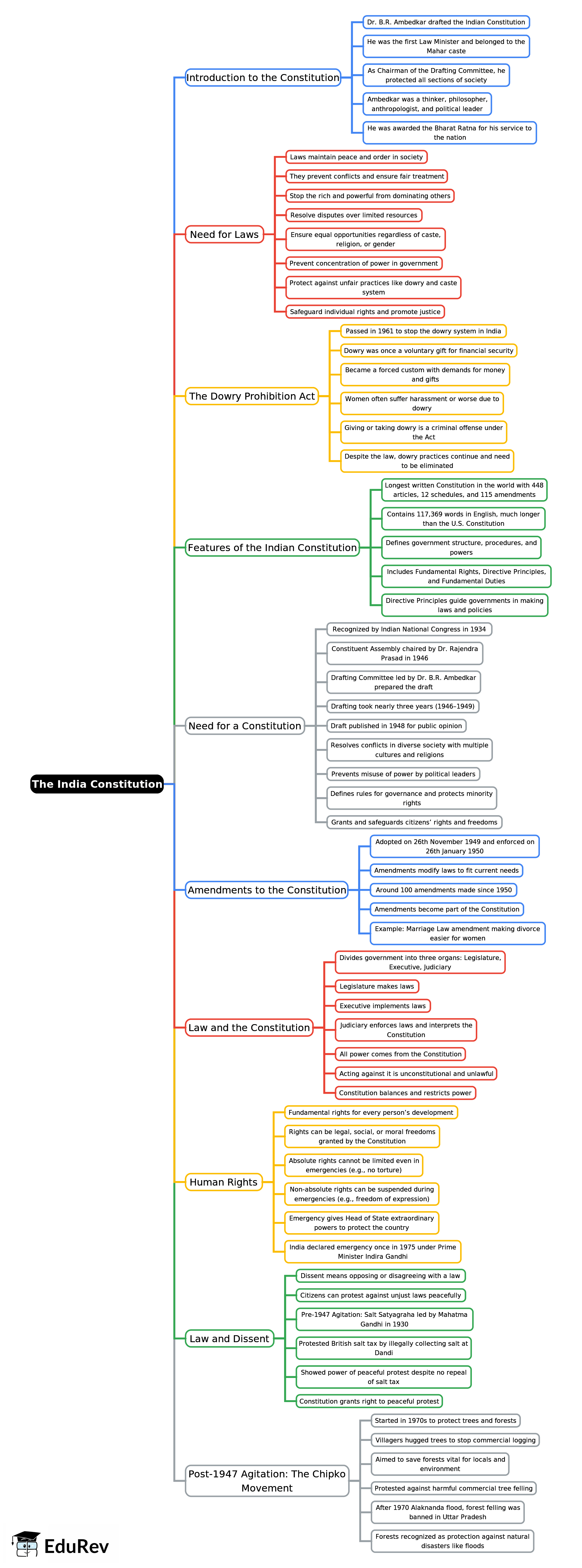CTET & State TET Exam > CTET & State TET Notes > Social Studies & Pedagogy Paper 2 for CTET & TET Exams > Mind Map: The Indian Constitution
Mind Map: The Indian Constitution | Social Studies & Pedagogy Paper 2 for CTET & TET Exams - CTET & State TET PDF Download

The document Mind Map: The Indian Constitution | Social Studies & Pedagogy Paper 2 for CTET & TET Exams - CTET & State TET is a part of the CTET & State TET Course Social Studies & Pedagogy Paper 2 for CTET & TET Exams.
All you need of CTET & State TET at this link: CTET & State TET
|
75 videos|311 docs|77 tests
|
FAQs on Mind Map: The Indian Constitution - Social Studies & Pedagogy Paper 2 for CTET & TET Exams - CTET & State TET
| 1. What is the significance of the Indian Constitution? |  |
Ans. The Indian Constitution is the supreme law of India that lays down the framework for the political principles, procedures, and powers of government institutions. It establishes the fundamental rights and duties of citizens and seeks to promote justice, liberty, equality, and fraternity among the people. Its significance lies in providing a legal foundation for democracy, ensuring the rule of law, and protecting the rights of individuals against any form of oppression.
| 2. How does the Indian Constitution ensure the separation of powers? |  |
Ans. The Indian Constitution ensures the separation of powers by dividing the responsibilities and powers of government into three branches: the Executive, the Legislature, and the Judiciary. Each branch has distinct functions: the Executive implements laws, the Legislature makes laws, and the Judiciary interprets laws. This separation helps prevent the abuse of power by ensuring that no single branch can dominate the others, thus maintaining a system of checks and balances.
| 3. What are the fundamental rights guaranteed by the Indian Constitution? |  |
Ans. The Indian Constitution guarantees six fundamental rights to its citizens: Right to Equality, Right to Freedom, Right against Exploitation, Right to Freedom of Religion, Cultural and Educational Rights, and Right to Constitutional Remedies. These rights ensure that every citizen has equal opportunities and protection under the law, freedom of expression, religious freedom, and the ability to seek legal recourse against violations of their rights.
| 4. What is the process of amendment of the Indian Constitution? |  |
Ans. The process of amending the Indian Constitution is outlined in Article 368. Amendments can be made in three ways: by a simple majority of the Parliament, by a two-thirds majority of the Parliament, or by a two-thirds majority of the Parliament along with the ratification by half of the state legislatures. This flexible yet rigorous process ensures that the Constitution can evolve with changing times while maintaining its core principles.
| 5. How does the Indian Constitution promote social justice? |  |
Ans. The Indian Constitution promotes social justice through various provisions aimed at reducing social inequalities and ensuring the welfare of marginalized groups. It includes measures like affirmative action for Scheduled Castes, Scheduled Tribes, and other backward classes, as well as provisions for the protection of minority rights. By doing so, the Constitution seeks to create an equitable society where every individual has access to opportunities and resources, thus fostering social harmony.
Related Searches
















